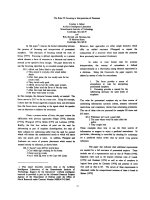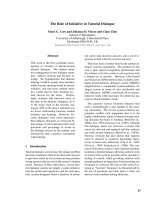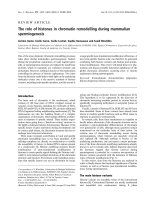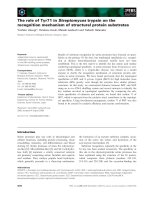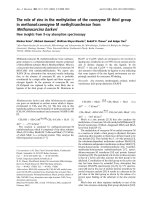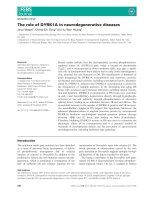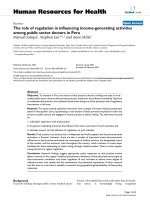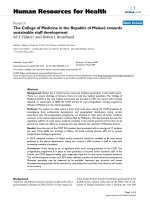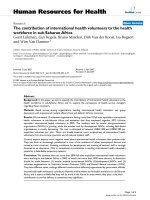báo cáo sinh học:" The role of leadership in HRH development in challenging public health settings" potx
Bạn đang xem bản rút gọn của tài liệu. Xem và tải ngay bản đầy đủ của tài liệu tại đây (254.03 KB, 7 trang )
BioMed Central
Page 1 of 7
(page number not for citation purposes)
Human Resources for Health
Open Access
Commentary
The role of leadership in HRH development in challenging public
health settings
Judith Schiffbauer
†1
, Julie Barrett O'Brien
†1
, Barbara K Timmons*
†1
and
William N Kiarie
†2
Address:
1
Management Sciences for Health, Cambridge, MA, USA and
2
Crystal Hill Consulting, Nairobi, Kenya
Email: Judith Schiffbauer - ; Julie Barrett O'Brien - ; Barbara K Timmons* - ;
William N Kiarie -
* Corresponding author †Equal contributors
Abstract
As part of the special feature on leadership and human resources (HR), Management Sciences for
Health profiles three leaders who have made a significance difference in the HR situation in their
countries. By taking a comprehensive approach and working in partnership with stakeholders,
these leaders demonstrate that strengthening health workforce planning, management, and training
can have a positive effect on the performance of the health sector.
Three profiles are presented, from Afghanistan, South Africa, and Southern Sudan, revealing
common approaches and leadership traits while demonstrating the specificity of local contexts.
Introduction
As part of the special series on leadership and human
resources (HR), Management Sciences for Health profiles
three leaders who have made a significant difference in
the HR situation in their countries. By taking a compre-
hensive approach and working in partnership with stake-
holders, these leaders demonstrate that strengthening
health workforce planning, management, and training
can have a positive effect on the performance of the health
sector.
Discussion
Afghan Leadership in Human Resources for Health:
Overview
Problem
Afghanistan lacks health care providers, especially female
providers – in a traditional culture in which women can
be cared for only by other women – and many workers'
skills need to be upgraded.
Approach
The Director of Human Resources (HR) at Afghanistan's
Ministry of Public Health (MOPH) formed a leadership
group that includes representatives from throughout the
government, professional associations, unions, universi-
ties, and civil society. This group established a Directorate
of Human Resources and helped link its work to that of
other departments. The Directorate established a national
registration system and a database of health workers. A
board was established to test and certify staff in nine cate-
gories of nursing, midwifery, and allied health.
Local Setting
After decades of conflict, Afghanistan has some of the
worst health indices in the world. The maternal mortality
ratio translates into a lifetime risk that one in seven
women will die of complications of pregnancy and child-
birth [1]. Twenty-six percent of children will die before
their fifth birthdays [2]. The country is bisected by high
Published: 4 November 2008
Human Resources for Health 2008, 6:23 doi:10.1186/1478-4491-6-23
Received: 29 April 2008
Accepted: 4 November 2008
This article is available from: />© 2008 Schiffbauer et al; licensee BioMed Central Ltd.
This is an Open Access article distributed under the terms of the Creative Commons Attribution License ( />),
which permits unrestricted use, distribution, and reproduction in any medium, provided the original work is properly cited.
Human Resources for Health 2008, 6:23 />Page 2 of 7
(page number not for citation purposes)
mountains that make transportation and access to services
very difficult.
Relevant Changes
The HR database now contains information about 24 500
health workers, 2400 of whom have been tested for certi-
fication. Nursing and midwifery curricula have been
revised, and an accreditation system for midwifery educa-
tion is in place. Afghanistan's Institute of Health Sciences
had graduated 800 professional midwives, the first
trained in Afghanistan in seven years, by September 2006;
two years later, this number exceeded 1100. The Directo-
rate of Human Resources also established a competitive,
transparent system for civil service recruitment.
Lessons Learned
Changes that require working across the government are
complex, but working together to achieve consensus has
been successful in advancing HR for health in Afghani-
stan. It has been important to elevate the HR function in
the MOPH and establish mechanisms for interdepartmen-
tal work on HR.
Leadership Profile: Dr. Bashir Noormal
From 2003 to 2006, Dr. Bashir Noormal served as Direc-
tor of Human Resources at the MOPH, where he and his
staff laid the foundation for developing and managing HR
in a country facing some of the world's greatest health
challenges. The Ministry works with many partners,
including the Aga Khan Foundation, the Japan Interna-
tional Cooperation Agency, and Management Sciences for
Health.
"Afghan health statistics are heartbreaking," says Dr.
Noormal. "One of the most tragic is a maternal mortality
rate of over 1600 per 100 000 live births. When it comes
to dealing with this and other health problems, human
resources are paramount. In Afghanistan, where for two
decades war interrupted – and often utterly prevented –
the education of health providers, we have two particu-
larly severe obstacles to overcome: our number of health
care providers – especially females – is too small, and the
quality of our providers is too low."
To address these challenges, Dr. Noormal formed a lead-
ership group that included managers from different levels
of the MOPH, representatives from the Ministries of Edu-
cation and Finance and the Civil Service Commission,
professional associations, unions, and universities. His
team also included representatives from civil society,
which delivered health services during the years of con-
flict.
Because of the urgency of HR issues in Afghanistan, one of
the first things the group proposed was elevating the HR
function to the directorate level in the Ministry. This
change would enable it to coordinate all aspects of HR,
which were previously spread throughout the MOPH.
Once the Directorate of Human Resources was estab-
lished, it defined how this unit would work with the other
units that had previously covered HR functions, for exam-
ple, NGOs that are contracted to deliver primary health
care services through the Grants and Contracts Manage-
ment Unit of the MOPH. This resulted in what Dr. Noor-
mal calls the "linkages model." This model was useful in
showing what combination of ministry departments
could be drawn together to address common goals and
how to best link to the provinces.
With an organizational basis for HR established, one of
the Directorate's first tasks was to identify the numbers,
types, and locations of health workers in the country and
determine their level of competency. Among the many
refugees returning to Afghanistan were health workers
trained by NGOs operating cross-border projects in Paki-
stan during the war, who, out of necessity, had expanded
their roles beyond their training. Others had no formal
training but nevertheless provided health care during the
war years. Still others may have received training irrele-
vant to their current jobs.
To address this array of health workers and begin to build
a consistent level of quality into the HR system, the Direc-
torate of Human Resources put in place a national regis-
tration system and created a database that details the
training and background of 24 500 health workers. A
semi-autonomous board was established to test and cer-
tify staff in nine categories of nursing, midwifery, and
allied health. Approximately 2400 people have been
tested to date.
While it is imperative to increase the number of Afghani-
stan's health workers, the quality of their training is also
crucial. Dr. Noormal cites an Afghan proverb to make this
point: "One excellent soldier is better than an entire army
with poor skills."
High-quality training is being provided to refresh the
skills of health workers and train new ones, especially
female doctors, nurses, and midwives. Both nursing and
midwifery preservice curricula have been revised. An
accreditation system for nursing education is being final-
ized, and a system of accreditation for midwifery educa-
tion has been established. With these new standards,
Afghanistan's Institute of Health Sciences had graduated
800 professional midwives, the first trained in Afghani-
stan in seven years, as of September 2006. By September
2008, this number had reached 1128.
Under Dr. Noormal's leadership, the Directorate of
Human Resources also established a competitive, trans-
parent system for civil service recruitment. As the only
Human Resources for Health 2008, 6:23 />Page 3 of 7
(page number not for citation purposes)
ministry to have established these systems and standards,
the MOPH has been identified by the Afghanistan Civil
Service Commission as one of the lead ministries in the
government to implement civil service reform.
Dr. Noormal knows that the measures the Directorate has
taken are not the sole solutions to Afghanistan's health
problems. Once a cadre of well-trained health care provid-
ers exists, men and women must still be recruited and
deployed to rural areas, where they are desperately
needed.
With the help of donors, the MOPH has instituted a sys-
tem of generous salary incentives to induce health care
providers, especially women, to work in rural areas, says
Dr. Noormal, "but," he adds, "such incentives will remain
insufficient unless other measures are also taken." Security
must be strengthened in all areas of the country. In addi-
tion, female health care providers will traditionally not
relocate without their families, which means there must
be schools for their children, employment for spouses,
and adequate housing. "These things," Dr. Noormal
points out, "are not under MOPH control, but rather
require the cooperative efforts of the entire Afghan gov-
ernment."
Dr. Noormal's approach to achieving the gains made by
the Directorate of Human Resources has been character-
ized by a process of reaching consensus and developing
and instilling a shared vision. Ideas and issues discussed
and agreed upon by the HR Taskforce are taken to senior
MOPH officials. Matters of policy and guidelines are
shared with stakeholders before they are approved by the
MOPH Executive Board. Implementation has taken place
with the help of donors and MOPH partners. "Their sup-
port has been a vital component of our successes," states
Dr. Noormal.
Still exhibiting the energy and determination that have
sustained him throughout these formidable tasks, in June
2006, Dr. Noormal turned over the reins to Dr. Salam
Jalali, former director of Kabul's Indira Gandhi Institute.
The two men fully agree on the importance of continuing
and building upon the HR systems that the MOPH estab-
lished during Dr. Noormal's tenure.
Having reassumed his position as Director of Human
Resources Development for the World Health Organiza-
tion's office in Afghanistan, Dr. Noormal continues to
support improvement in the number and quality of
Afghanistan's health workers. As the WHO representative
on the Ministry's HR Taskforce, he remains actively
involved in developing and improving HR management
at the MOPH. Dr. Jalali, who values his input, invited him
to serve as an advisor to the Directorate of Human
Resources.
"The human resource work we have begun is of the
utmost importance," states Dr. Noormal. "Our priority is
to improve the health of all Afghans, and to do so,
Afghanistan must develop its human resources to the full-
est and manage them wisely."
Emergency Health Workforce Planning in South Africa:
Overview
Problem
South Africa's health system is facing a shortage of trained
health staff of serious proportions. In rural communities
where the spread of HIV & AIDS is escalating, providing
an adequate pool of qualified health professionals is dif-
ficult. Low salaries and poor working conditions deter
people from pursuing public health professions, exacer-
bating the problem of migration of health workers to the
private sector and wealthier countries.
Approach
Under the auspices of South Africa's National Department
of Health (NDOH), Dr. Percy Mahlathi, Deputy Director
General of Human Resources, led a multisectoral team to
identify the sources of South Africa's human resource
(HR) challenges. Using the World Health Organization's
HR Toolkit (2004) as a basis for developing a strategic
framework, the project team developed a National
Human Resources for Health Plan, which provides
national guidelines for HR development, management,
and training [3].
Local Setting
According to the South Africa Institute for Race Relations,
the public sector had only 7645 doctors (of the 30 000
registered). The Institute found the number of doctors
"alarmingly low": "the local doctor to population ratio
was 0.7 doctors per 1,000 people – as opposed to 2.1 in
Egypt and 1.2 in the Philippines" between 1994 and 2004
[4]. While South Africa is committed to recruiting and
training highly qualified health care managers, it contin-
ues to grapple with the migration of these people to more
developed nations. Since the end of apartheid, career
opportunities outside health have increased, as has com-
petition for top students. Many look outside health care –
a field that historically was the only career path for black
South Africans – because they have witnessed the hard
work and poor conditions that their parents endured for
very low wages. Both the Departments of Health and Edu-
cation are looking for ways to change this image and pro-
mote health sciences as a career option.
Relevant Changes
According to the Department of Health's 2007 annual
report, significant progress has been made in HR in four
provincial Departments of Health: a new remuneration
system for health professionals, policies and curricula for
mid-level health workers, training for Clinical Associates,
Human Resources for Health 2008, 6:23 />Page 4 of 7
(page number not for citation purposes)
and strategies to strengthen the nursing profession are in
place [5]. Nationally, a community service program has
decreased migration of new graduates, 3800 of whom
have been deployed to rural areas.
Lessons Learned
Although progress has been made, many challenges
remain and addressing them requires a multisectoral
approach. Strong health management and leadership and
additional human and financial resources will help meet
the needs of South Africa's citizens.
Leadership Profile: Percy Mahlathi
More than 13 years after gaining independence and hold-
ing its first democratic elections, South Africa has much to
be proud of. The reconstruction, nation-building, and
democratization that ensued during the past decade ena-
bled the merging of various states and authorities into one
unified "rainbow nation." With gains in some develop-
ment indicators and a growing economy, South Africa has
become an influential country, not only in the region but
increasingly throughout the world.
Despite these achievements, South Africa has one of the
highest numbers of people living with HIV in the world,
with a 2008 estimate of 5.7 million or almost one in five
adults [6]. While the country is no longer separated along
racial lines, South Africa's health system retains many
inequities from the apartheid era, and a major challenge
for the government is to improve the accessibility and
quality of basic health services for its majority population.
Dr. Percy Mahlathi of South Africa was the only one in his
elementary school class to attend high school. That he
made it through medical school during a time when
South Africa struggled with extreme social inequities is a
testament to his leadership, commitment, sense of justice,
and drive. That he is currently preparing leaders to build
South Africa's health sector while making significant con-
tributions to world health is admirable.
Dr. Mahlathi, Deputy Director General of Human
Resources for South Africa's national Department of
Health (DOH), took office in 2004 – exactly 10 years
post-apartheid. In this role, he is charged with counteract-
ing the ever-present brain drain; ensuring that health
workers are experienced and competitively paid; improv-
ing working conditions; and seeing that rural communi-
ties have access to a consistent supply of well-trained
health professionals who can provide primary health serv-
ices while tackling the AIDS epidemic.
To address the migration of health professionals, Dr.
Mahlathi reached out to others both within and outside
the national DOH. Together they scanned the environ-
ment and analyzed the root causes of their most critical
challenges. This analysis enabled Dr. Mahlathi to finalize
a national plan for HR management. But he realized that
for the plan to be successfully implemented, the process
needed to be guided by skilled leaders and managers at all
levels.
Creating a Successful National Plan
As part of the national efforts, Mahlathi distinguishes five
key points as essential to guide the implementation of the
national HR plan for health:
HR development: Develop highly qualified health leaders
and professionals, including HR managers.
Multisectoral planning: Create coordinated plans with the
private and public sectors, encompassing education, eco-
nomic development, justice, transportation, and commu-
nication.
Harmonization in the public sector: Work with the
National Treasury and Department of Education to lead
the provinces in addressing their issues through a 'harmo-
nized' approach.
Working with trade unions: Because South Africa's health
services depend on people, prioritize quality of care and
health workers' competence while working with trade
unions to improve working conditions and remuneration
for health workers.
International leadership: Since health systems throughout
the world are interdependent – as avian influenza, AIDS,
and tuberculosis have shown – South Africa must take a
leadership role and produce more opinion leaders.
Results of the Plan for HR for Health
Many health workers continue to look outside Africa for
career opportunities. Highly skilled health professionals
are migrating to Saudi Arabia, New Zealand, the United
Kingdom, and Canada in record numbers [7]. Compelling
them to stay poses an ethical question that challenges
South Africa's democratic constitution, which recognizes
its citizens' rights to determine their future and move any-
where in the world.
One way in which the DOH has addressed the rapid
migration of new graduates, short-term need for health
care workers, and the lack of health workers in rural areas
has been introducing a program that requires health stu-
dents to perform community service before they can be
registered by the Medical and Dental Board of South
Africa or South African Nursing Council [8]. In the begin-
ning, this policy was unpopular. Many who grew up in
urban settings did not want to travel and live in rural com-
Human Resources for Health 2008, 6:23 />Page 5 of 7
(page number not for citation purposes)
munities where there was little to do. Once there, how-
ever, many health professionals, from pharmacists to
dentists, found the work fulfilling. Mahlathi spoke
proudly about two young medical school graduates from
Johannesburg who were assigned to Limpopo Province.
One year later they asked for an extension, stating that the
"people were so generous and respectful."
Today, there are more than 3800 health professionals
working in the community service program. The success
of the program has impressed others in the public sector:
both the justice and engineering sectors are looking to
community service as a means of addressing their short-
term staffing issues.
In a country where the burden of HIV & AIDS is intensify-
ing, Mahlathi knows that realizing his vision requires
developing strong HR leaders. "We cannot aspire for
mediocrity," Mahlathi asserts. "We need to leverage the
skills of the people we have by developing strong leaders
in programs that have been cooked at home – leaders who
can clearly articulate and execute South Africa's health
vision and planned outcomes." He believes that programs
initiated and led internally are more relevant than foreign
ones because they build confidence in South Africa's
vision and strengthen the country's capacity in HR man-
agement. Mahlathi is also confident that South Africa
today has the ability and the resources to achieve its goals.
But all actions must be directed toward building strong
HR management systems and increasing public awareness
and the appeal of the health care industry.
"South Africa has always had good opportunities," he
points out. "We have always had good resources and
skills. But we've never had a situation where we have effec-
tively managed the human resource crisis in health. We
must provide our future health leaders with opportuni-
ties. Then South Africa will succeed."
Leading the Development of Human Resources for Health
in Southern Sudan: Overview
Problem
Sudan needs to scale up health services despite serious
shortages of workers in all health professions: there are
only slightly more than 100 doctors and 5 pharmacists to
serve more than 10 million people scattered throughout a
huge country with virtually no road network [9].
Approach
The Director for Human Resource Development and Plan-
ning in the Ministry of Health (MOH) of Southern Sudan
is leading the achievement of public health goals by col-
laborating with stakeholders, focusing on HR priorities,
mobilizing resources, and building leadership and man-
agement capacity.
Local Setting
Sudan has some of the worst health indicators in the
world. Almost 1 in 10 Sudanese children die before reach-
ing their fifth birthdays, while maternal mortality is esti-
mated at 590 per 100 000 live births. In Southern Sudan,
malaria, acute respiratory tract infections, and diarrhoeal
disease are major killers. Only 34% of eligible children are
immunized against measles, and 94% of deliveries take
place at home [10].
Relevant Changes
After an HR assessment, Southern Sudan's MOH made
progress in addressing the shortage of workers by training
health managers in HR management and leadership;
repatriating doctors from Canada and recruiting health
workers from East Africa; scaling up training of mid-level
workers; developing an HR policy; developing preservice
training curricula; and establishing a national HR infor-
mation system.
Lessons Learned
Education of health workers and professionalization of
management and leadership are crucial. Coordinating the
activities of donors and partners is equally important to
produce health workers to meet the needs of the country.
Leadership Profile: Dr. Monywiir Arop Kuol
In Southern Sudan, as in many countries that are grap-
pling with a critical shortage of health workers, dynamic
HR directors make a difference. Dr. Monywiir Arop Kuol
is such a leader. He is contributing to achieving public
health goals by working collaboratively with stakeholders,
focusing on HR priorities, mobilizing resources, and ena-
bling others to lead and manage in order to achieve sus-
tainable results.
Although drought, famine, poverty, and war have afflicted
Sudan for decades, Sudanese leaders in public health have
a vision of a better future. A general practitioner, Dr.
Monywiir knows these problems well, since he has been
managing relief services in Sudan since 1990. Dr. Mony-
wiir currently serves as Director for Human Resource
Development and Planning in the MOH of Southern
Sudan. In this role, he is responsible for policy develop-
ment, planning, coordination with many partners, super-
vision, and monitoring and evaluation.
In his 20-year career in health systems and services, Dr.
Monywiir has done everything from community mobili-
zation to fundraising. During the civil war, he spent many
years in the bush. His responsibilities ranged from treat-
ing wounded soldiers to managing education programs in
the areas controlled by the Sudan People's Liberation
Army. Dr. Monywiir is passionate about helping young
people – he would like to see the many brilliant and hard-
Human Resources for Health 2008, 6:23 />Page 6 of 7
(page number not for citation purposes)
working young people, especially those who served with
him and missed opportunities to go to high school and
college, be able to acquire useful skills and education.
In high school, Dr. Monywiir dreamed of becoming an
engineer. When the time came for him to go to the univer-
sity, however, the community elders unanimously
decided that he should study medicine, so young Mony-
wiir headed off to the University of Juba in Southern
Sudan. Although he was not consulted, Dr. Monywiir con-
fesses that he grew to like the subject and graduated at the
top of his class.
More recently, Dr. Monywiir has established and operated
relief agencies, coordinated the activities of health NGOs,
and worked for the International Rescue Committee in
Sudan. His vision is for Southern Sudan to have "efficient,
equitable, and advanced health services provided by a
highly skilled and motivated workforce."
Since the peace agreement was signed between the
national government of Sudan in Khartoum and the
Sudan People's Liberation Movement in the south in
2005, donors have committed US$ 484 million to the
trust funds of the two governments. In the south, these
funds are being used to expand basic health services for
the 75% of the people of Southern Sudan who lack access
to services. Donors are helping to develop the capacity of
the MOH and are investing in infrastructure, pharmaceu-
ticals, and equipment [11].
Against this backdrop, Dr. Monywiir recognized the need
to collaborate with all relevant partners – including the
World Bank, World Health Organization, United Nations
agencies, NGOs, civil society, the private sector, and the
ministries of education and public service – to produce
health workers. He established a leadership team that
included members of his staff and representatives of
donor agencies and technical assistance organizations.
Among Dr. Monywiir's goals for this team was to harmo-
nize the activities being proposed.
As part of its initial scanning, the team surveyed existing
health services and staff and collected data about the ele-
ments of an effective HR management system. Including
HR management issues in the baseline survey proved
invaluable as Dr. Monywiir and his staff began to organize
HR functions and the policies to support them.
The baseline assessment identified many HR problems –
among them, low salaries, unavailability of jobs, lack of
infrastructure, and low levels of education – and enabled
the leadership group to identify priorities. As Sudan
emerges from two decades of civil strife, it needs to attract
health workers back into the country, which has only
about one health worker per 1000 people [12]. Dr. Mony-
wiir is leading efforts to attract health workers to return.
Sudanese doctors in Canada have come back to Southern
Sudan to work in public and NGO health facilities.
Some of these problems cannot be addressed directly by
the MOH, but in keeping with Dr. Monywiir's collabora-
tive approach, a mechanism is already in place to support
action on these critical fronts. Meanwhile, he and his team
have focused on:
▪ creating a plan for human resources for health, with an
emphasis on training midwives (who are urgently needed
to help lower the maternal mortality rate);
▪ developing an HR policy;
▪ addressing gender inequalities;
▪ developing HR and leadership capacity among managers
at the central and regional levels.
The last priority exemplifies Dr. Monywiir's visionary
approach. He recognizes that without professional HR
leaders and managers throughout the system, his dreams
for improving health in his country will fail. With the sup-
port of USAID and other partners, the MOH's HR directo-
rate has been involved in developing the HR management
and leadership skills of public- and private-sector health
managers. In 2006, a workshop for stakeholders in
human resources for health was held in Juba, Southern
Sudan. Participants were introduced to best practices in
HR management and new models for leading and manag-
ing: the Global Health Workforce Alliance's Human
Resources for Health Framework and MSH's Leading and
Managing for Results Model. A program is underway to
train health managers from various regions in Southern
Sudan in HR and leadership skills. To build his own
knowledge, Dr Monywiir attended a one-month course
on human resources for health at the University of New
South Wales in Australia.
Dr. Monywiir asserts that in the new Southern Sudan,
"Human resource management policies and practices will
have to be innovative, humane, and competence based."
He and others in the MOH are supporting this evolution
by developing HR policies, plans, and guidelines. A
national HR policy has been finalized, and work on a 10-
year strategic plan has begun.
Other initiatives include establishing and rehabilitating
training programs and institutions in Sudan (which has
14 medical training institutions) and neighboring coun-
tries. Nurses, laboratory technicians, and community
health workers are being trained to upgrade their skills
Publish with BioMed Central and every
scientist can read your work free of charge
"BioMed Central will be the most significant development for
disseminating the results of biomedical research in our lifetime."
Sir Paul Nurse, Cancer Research UK
Your research papers will be:
available free of charge to the entire biomedical community
peer reviewed and published immediately upon acceptance
cited in PubMed and archived on PubMed Central
yours — you keep the copyright
Submit your manuscript here:
/>BioMedcentral
Human Resources for Health 2008, 6:23 />Page 7 of 7
(page number not for citation purposes)
and enable them to train new health workers. Southern
Sudan is also recruiting health workers from "the rich
regional workforce market of East Africa, where there is
immense expertise and a culture of hard work," explains
Dr. Monywiir. To provide accurate and timely data on the
progress being made, the MOH has developed a compre-
hensive HR information system, which will greatly
improve HR planning and management.
Dr. Monywiir is committed to help rebuild the country
and use its abundant natural resources by making a
healthy workforce available so that social-sector services
can be re-established. To date, he and his team can point
to the following achievements:
▪ more than 30 health managers trained in HR manage-
ment
▪ more than 30 health managers trained in management
and leadership
▪ HR policy developed
▪ training of mid-level health cadres scaled up
▪ preservice training curricula for health workers devel-
oped or standardized
▪ nationwide HR information system developed
▪ 15 doctors repatriated from Canada.
Conclusion
HR leaders show the way through their commitment and
creativity, informed by experience about what works. In
Afghanistan, South Africa, and Southern Sudan, leaders
have succeeded in very different settings by using some
common strategies: a multisectoral approach and com-
prehensive planning; development of an HR policy; estab-
lishment of a dedicated HR unit and training of HR
managers; expanded recruitment and training, testing,
and certification of health workers; revision of preservice
training curricula; and a nationwide HR information sys-
tem.
Competing interests
The authors declare that they have no competing interests.
Authors' contributions
JS wrote the section of this article on Afghanistan, while
JBO wrote the section on South Africa, and WNK drafted
the section on Southern Sudan, for which BKT provided
research and writing. BKT edited the entire article. All
authors read and approved the final manuscript.
Acknowledgements
Partial funding for the first section of this article was provided by the US
Agency for International Development under the REACH program, con-
tract number EEE-C-00-03-00021-00. The opinions expressed herein are
those of the authors and do not necessarily reflect the views of USAID.
References
1. Bartlett L, Mawji S, Whitehead S, Crouse C, Dalil S, Ionete D, Salama
P: Where giving birth is a forecast of death: maternal mortal-
ity in four districts of Afghanistan, 1999–2002. Lancet 2005,
365:864-870.
2. United Nations Children's Fund (UNICEF): The state of the
world's children, 2008: child survival. New York: UNICEF; 2007.
3. South Africa, DOH: A national human resources plan for
health. 2006 [ />SOUhres_200307.pdf].
4. "SAFP Newsroom": South African Family Practice. 2006, 48(3):
[ />].
5. South Africa, DOH: Annual national health plan 2006/07.
[ />].
6. UNAIDS: "Epidemiological Fact Sheet on HIV and AIDS:
Core data on epidemiology and response: South Africa.".
2008 [ />full/EFS2008_ZA.pdf].
7. Mahlathi P: "Sharing health professionals with the world: A
South African perspective on global health workforce
issues.". [ />pdf_percy_mahlathi_summary.pdf].
8. Mahlathi P: "Community service to improve access to quality
health care to all South Africans.". [ />docs/pr/2006/pr0105.html].
9. Arop M: MOH, Southern Sudan, in an e-mail from W Kiarie
to M O'Neil of MSH. . March 31, 2006
10. World Health Organization (WHO): The world health report 2005:
make every mother and child count Geneva: WHO; 2005:179, 217.
11. World Bank: International support continues to help rebuild
southern Sudan. Washington, DC: World Bank. Feb. 21, 2006
12. Joint Learning Initiative: Human resources for health: overcoming the cri-
sis Cambridge, MA: Global Equity Initiative; 2004:157-62.

